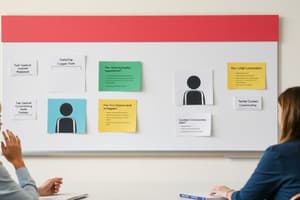Podcast
Questions and Answers
What type of rock art was created by applying red ochre or less commonly, black, white or yellow dye?
What type of rock art was created by applying red ochre or less commonly, black, white or yellow dye?
- Cave paintings
- Pictographs (correct)
- Codex
- Petroglyphs
Which of the following was NOT a form of media during the Industrial Age?
Which of the following was NOT a form of media during the Industrial Age?
- Printing Press
- Transistor Radio (correct)
- Telegraph
- Newspaper Production
What was the key invention that gave way for the Electronic Age?
What was the key invention that gave way for the Electronic Age?
- Motion pictures
- Printing Press
- Telephone
- Transistor (correct)
Which of the following was a key characteristic of the Industrial Age?
Which of the following was a key characteristic of the Industrial Age?
Which of the following media forms was used for mass production during the Industrial Age?
Which of the following media forms was used for mass production during the Industrial Age?
What was the primary purpose of the telegraph during the Industrial Age?
What was the primary purpose of the telegraph during the Industrial Age?
What type of communication involves sending or receiving wordless messages?
What type of communication involves sending or receiving wordless messages?
According to Berlo's Model of Communication, who is the person that originates the message?
According to Berlo's Model of Communication, who is the person that originates the message?
Which literacy skill involves the ability to use digital technology and communication tools effectively?
Which literacy skill involves the ability to use digital technology and communication tools effectively?
What is the term defined as a set of competencies that empower individuals to access, understand, evaluate, and create information and media content?
What is the term defined as a set of competencies that empower individuals to access, understand, evaluate, and create information and media content?
Which type of communication is done solely by word of mouth?
Which type of communication is done solely by word of mouth?
In the context of communication, what does the term 'Receiver' refer to?
In the context of communication, what does the term 'Receiver' refer to?
Study Notes
Media Information Literacy
- Refers to the essential competencies (knowledge, skills, and attitude) that allow citizens to engage with media and other information providers effectively and develop critical thinking and life-long learning skills for socializing and becoming active citizens.
The Evolution of Traditional Media to New Media
-
Pre-Industrial Age (before 1700)
- People discovered fire, developed paper from plants, and forged weapons and tools with stones and other materials.
- People learned to etch on caves, creating rock art, which includes petroglyphs and pictographs.
- Petroglyphs: images created by carving, engraving, or scratching the rock's surface to reveal the lighter layers beneath.
- Pictographs: paintings made by applying red ochre or other dyes.
- Other forms of media during this age: Cave paintings, Clay tablets in Mesopotamia, Papyrus in Egypt, Codex in Mayan Region.
-
Industrial Age (18th century)
- Began in Great Britain with drastic reforms to improve the economy.
- Technology shifted from using hand tools to operating power-driven machines.
- The power of steam was harnessed, and machine tools, iron production, and manufacturing of various products (including books through the printing press) developed.
- The telegraph was invented, revolutionizing long-distance communication.
- Other forms of media during this age: Printing Press, Telegraphs, Newspaper Production (1600s), Typewriter (1800), Telephone, Motion pictures (1890).
-
Electronic Age
- Electronic refers to an object with electronic components, such as sensors, microchips, which functions once connected to an electrical outlet.
- The invention of the transistor led to the transistor radio, electronic circuits, and early computers.
- Long-distance communication became more efficient in this age.
- Other forms of media during this age: Radio, Communication technology using radio waves.
Communication
-
Definition
- The act or process of using words, sounds, signs, or behaviors to exchange information and express ideas, thoughts, feelings that can result in understanding.
-
Types of Communication
- Verbal: Message is transmitted verbally; communication is done by word of mouth (oral and written).
- Non-Verbal: Sending or receiving wordless messages (signs, symbols, colors, gestures, body language, facial expressions).
-
Elements of Communication (Berlo's Model)
- Sender: Person who originates the message.
- Message: Content (piece of information) being communicated.
- Channel: Medium being used to transmit the message.
- Receiver: Person to whom the message is directed.
Key Terms
- Media Literacy: The ability to read, analyze, evaluate, and produce communication in a variety of media forms.
- Information Literacy: The ability to recognize when information is needed, locate, evaluate, effectively use, and communicate information in its various formats.
- Technology (Digital) Literacy: The ability to use digital technology, communication tools, or networks to locate, evaluate, use, and create information.
- Media and Information Literacy: Defined as a set of competencies that empower citizens to access, retrieve, understand, evaluate, use, create, as well as share information and media content in all formats, using various tools, in a critical, ethical, and effective way, to participate and engage in personal, professional, and societal activities.
Studying That Suits You
Use AI to generate personalized quizzes and flashcards to suit your learning preferences.
Description
Explore the different types of communication including verbal and non-verbal forms, along with understanding the elements of communication according to Berlo's Model.




